Mona Thakkar & Anne Speckhard A significant escalation in Islamic State (IS) attacks in Syria…
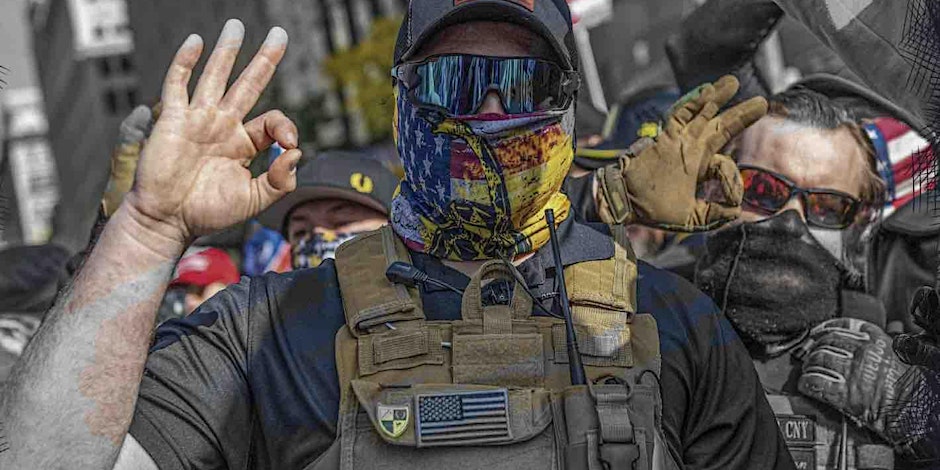
Developing and Testing Virtual Training for Police Prevention of Extremist Infiltration in Communities
Anne Speckhard & Sophia AbiNajm
Introduction
Targeted violence and violent extremism are on the rise in the United States and law enforcement personnel, specifically police officers and sheriffs’ deputies, are often the first line of defense in countering targeted violent extremist infiltration and recruitment attempts in their communities (https://www.splcenter.org/year-hate-extremism-2022). Law enforcement often have little training to effectively identify and intervene with these new challenges of individuals who are at-risk of radicalization, are being, or have already been radicalized; as well as to protect against community and policing infiltration attempts by violent extremist groups trying to gain access to vulnerable community members and to police training and weapons.
The International Center for the Study of Violent Extremism (ICSVE) is an internationally recognized and respected think tank for their research regarding the processes of radicalization, disengagement, deradicalization, rehabilitation and reintegration; prevention and intervention strategies; counter narrative videos and first-person video recorded interviews of over 800 terrorists and violent extremists. In 2022, ICSVE was awarded a US Department of Homeland Security Targeted Violence and Terrorism Prevention grant (Grant No: EMW-2022-GR-00076) to provide a comprehensive, evidence-based series of virtual and in-person multi-media trainings and follow-up briefs addressing law enforcement responses to violent extremism. The goal was for the trainings to be delivered to law enforcement and security professionals across the country and in the Washington, D.C. area to educate and prepare them for a new era of violent extremist radicalization and recruitment.
Creative and need-based approaches using multimedia presentations were developed by ICSVE based on actual case studies and research interviews to help police understand the psychosocial forces involved in radicalization to violent extremism, to prevent contributing to radicalization and to analyze psychosocial and policing perspectives on actual case studies of violent extremist events. The trainings took a whole-of-society view, taking into consideration systemic and developmental factors that make individuals highly vulnerable to recruitment, addressed the rise in online indoctrination and recruitment and the obstacles to detection for police and the factors which make exiting difficult for those already in such groups.
The project had two main objectives. The first objective was to provide American law enforcement with training and information that can be used to prevent violent extremist infiltration in their communities immediately and the second to provide proof of concept for the future development of a multimedia curriculum which can be disseminated to police and sheriff’s departments across the country and internationally as a virtual and perhaps even an asynchronous continuing education and training program.
Activities included developing six multi-media training modules delivered for law enforcement personnel followed by dissemination of related summary notes and research articles to all participants. Pre and post tests were administered, and the results were analyzed to verify that learning objectives were met. Likewise, the researchers collected participants’ reviews of the materials, trainers, and suggestions for future trainings. Additionally, 5-10 law enforcement participants from each training group were involved in short interviews to review the trainings, learn what was most useful for police, how to increase their accessibility and suggestions for improvements.
Methods
Six multi-media trainings were developed by ICSVE for this project and fine-tuned after review by DHS personnel and law enforcement feedback. Six PowerPoints now exist which include embedded links to videos of violent extremists speaking in their own words illustrating the concepts taught. Pre and post-tests were administered during the trainings and a final post-test was administered by email after which participants were issued a certificate of completion. Along with the certificate, concept papers were sent to participants after the trainings as well as the PowerPoints and links to the videos. Likewise, ICSVE staff interacted with trainees by email after the trainings answering questions and sending additional materials as needed.
Results
In total, 20 trainings were held from January 2023 to September 2024 in which 1457 security professionals from various law enforcement, intelligence and other security-related agencies participated. Of these 15 were held virtually and 5 were held in person. The in-person trainings were held for FBI Agents in the Washington, D.C. headquarters, for campus police in Baton Rouge and an additional two trainings (using a variant of the training materials) were also delivered to the National Intelligence University in Washington, D.C. to participants from the various U.S. intelligence organizations. (Because of the sensitive nature of these latter trainings no pre and post-test data was collected.)
Delivery Method
One of the objectives of this project was to learn how best to efficiently reach law enforcement trainees across the country from both rural and urban settings and to learn if virtual trainings would be accepted and embraced by the law enforcement community, given they avoid travel expenses and should be able to reach far more participants, particularly those from small and rural agencies.
As far as scheduling, feedback from our law enforcement interviews was that most security professionals don’t have a lot of time to devote to training and daily repeated, short trainings would be favored versus having to devote an entire day to it. Indeed, when in person trainings were offered for half or whole days those who were not in a learning institution (NIU for example) could only attend when not on duty, meaning forces would ask for two training days and divide their force in half to be able to attend on alternate days.
The virtual trainings were delivered daily for 1.5-hour sessions each day over one week and participant feedback was that this was a very useful delivery method and convenient schedule. Some law enforcement professionals even took part in the trainings over their phones while on duty out in the field.
Testing and learning that this training could be successfully delivered virtually with high engagement and excellent learning outcomes was also important in establishing this type of training as useful.
Measuring Learning Objectives
Pre and post-tests covering the main concepts of the trainings were administered to all participants, (except for those at NIU), and the results were analyzed to verify that learning objectives were met. The post test was administered at the end of the training and repeated via email in the week after the event to measure longer term retention. The testing was completed by 80 to 100 percent of the participants in all the trainings, with failure to participate due to those who participated over phones where the zoom survey failed at times. To bolster long-term retention of the learning objectives and sharing of learning over the police force the trainers also sent summaries and research papers out to the participants following the trainings.
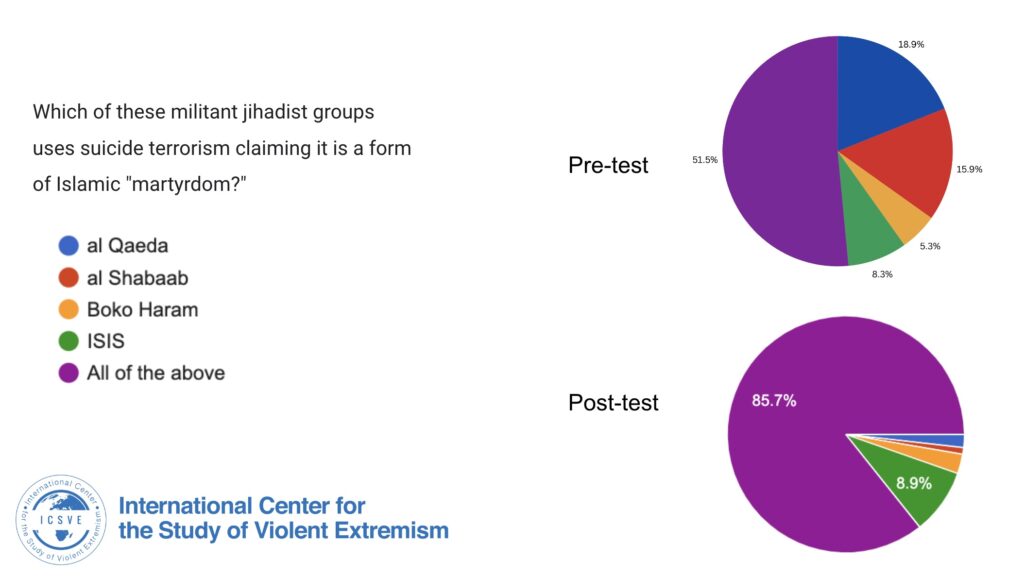
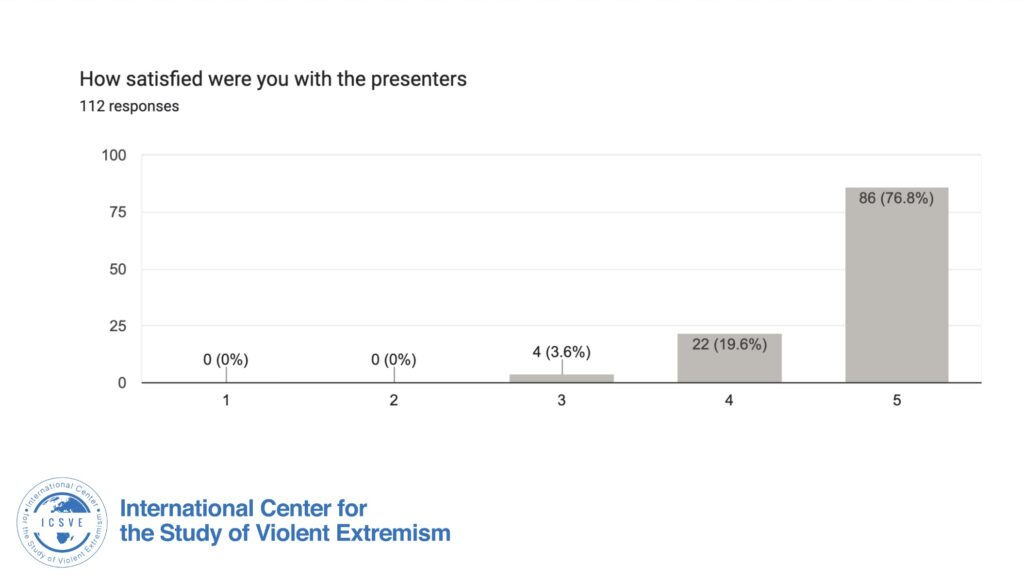

Above are three visual representations of the data we received from the pre and posttest answers given before and after the trainings. As you can see, the charts indicate a clear increase in the number of participants who correctly responded once the training concluded.
Community Building Across Security and Law Enforcement Agencies
Another objective of offering virtual trainings was to reach small community police forces and to make all participants aware of tools and fusion centers available to them and to engage with one another, versus just with the trainers. The virtual trainings included participants from law enforcement, intelligence and security institutions across the country and some internationals as well with many having considerable expertise and knowledge. To engage all of them maximally the trainers decided that in the case of the trainings offered via Zoom the participants were invited to engage using the chat feature which was left open throughout the training. To facilitate community building across law enforcement agencies the trainers greeted participants by name as the training event opened and acknowledged where they were coming from. The chat feature was introduced each day with participants invited to introduce themselves and interact freely with one another during the training and share resources. The participants were instructed not to insult one another, and anyone making offensive comments about race, religion, or similar topics would be removed. However, they were encouraged to chat freely, without worrying about interrupting or criticizing the trainers, as rich and open discussion is highly valued. As a result, the chat feature was actively engaged and many very useful comments were made, resources shared, websites posted, and papers uploaded to it. Likewise, these comments were addressed as well in a rich question and answer period which occurred in the last 20 to 30 minutes of the training. One of the trainers monitored the chat throughout, posted helpful links to related research papers and answered questions or directed them to the speaker’s attention when necessary. For the trainer, having the chat feature so actively engaged while speaking is somewhat disconcerting as participants did express their opinions, sometimes critical, and it could be distracting, but the richness of the discussion was well worth it. It was clear that participants began to know each other over the week, built trust and relationships and that community building was maximally engaged due to using the chat feature.
Interestingly, we did find that law enforcement participants were often reticent to speak up versus engage fully and contribute in the chat feature. This may be due to concern about showing their faces on the platform. In this regard, allowing international participation created a richness as law enforcement professionals from Turkey, EU, Brazil and beyond were less shy to speak up and often offered interesting case examples that helped engage U.S. participants in thinking over the pros and cons of various prevention and intervention responses to violent extremism.
Participation and Participant Satisfaction
The final emailed survey asked participants to rate the trainer and training materials. The results were overwhelmingly positive. One surprising result in terms of participation was that when the researchers offered certificates of completion it was overwhelmingly met positively, and participants e-mailed the researchers repeatedly to ensure they received theirs and some proudly posted their certificates on LinkedIn and other social media sites.
Another objective of the training was to address issues which are very polarizing in the current political environment in a way that did not repel participants. In the first trainings critical comments were made by those who felt the trainers were putting too much focus on addressing white supremacism and anti-government militia violent extremism and not enough on Antifa’s violence. This was addressed by covering all the major violent extremist groups, left and right wing, and giving clear statistical data on which groups are the most violent in the current political climate. This muted most criticism, but critical comments were still made by some about resources and tools covered when they were from the Anti-Defamation League or Southern Poverty Law. The trainer generally acknowledged criticisms gracefully but refuted them with statistics when possible.
The participants also stated that the psychosocial and multimedia approach was very helpful and that being able to hear actual violent extremists tell their stories on video made it so real and interesting for them. Many requested the PowerPoints and video links to be able to share with colleagues which led us to routinely send them out after the trainings.

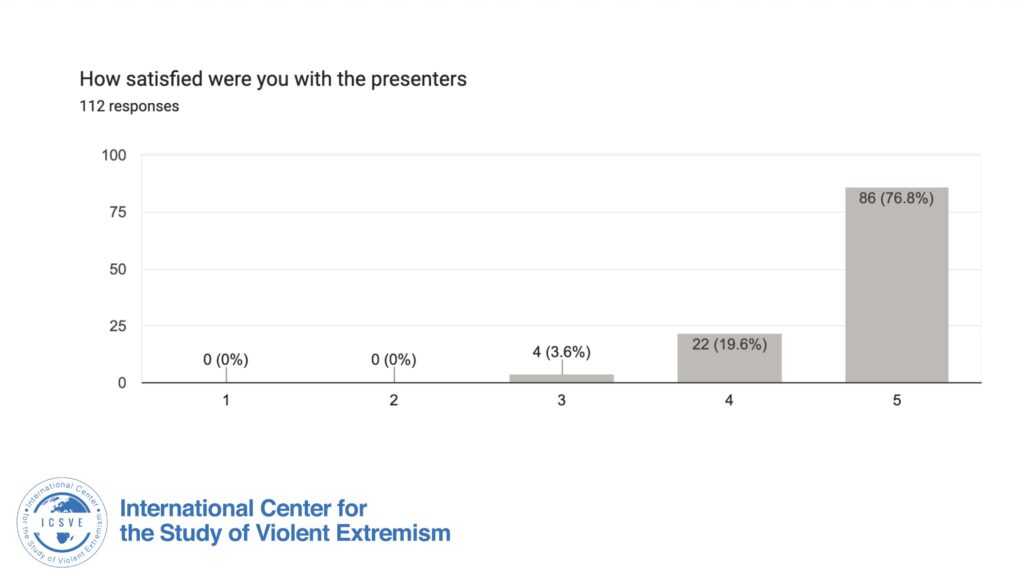

The training was enthusiastically embraced both by law enforcement who invited the trainers to come in person and by those who participated virtually. While it was apparent that participants have demanding jobs they engaged well with the course and were very satisfied with taking time to take the course. They also really appreciated receiving certificates of completion. Many stayed in email touch after the event and took other trainings offered by ICSVE as well (i.e. our DOJ Hate Crimes Prevention Course, as well as others).
Some of the comments from participants include:
“Dr. Speckhard’s lecture was so well received; I know you your students will take away a lot of good information.” – Washington, D.C.
“Great event.” – New York
“Excellent presentations; very informative videos.” – Maryland
“Your presentation is profound and has so much depth into the facets of radicalization to violence.” -– Washington, D.C.
“Great Lesson Plan and I Learned a lot.” – California
You are very popular at the University. Again, thank you for your visit to NIU and engaging with my colleagues on further visits. – Washington, D.C.
Sustainability
The trainings ended with the grant’s completion, but the trainers have shared all the training PowerPoints with participants, many who said they shared it widely in their networks. Likewise, the training materials now exist on our website here, where they can be accessed for asynchronous training. Sending out the PowerPoints and links to the videos and later making them available on our website not only made it possible for self-training to occur but also for train-the-trainers type dissemination to occur now and into the future. It was our hope to also post the video recorded trainings, but DHS advised against this as participants who interacted with the trainers could also be viewed on the recordings.
Challenges and Lessons Learned
The challenges encountered in this program were multiple:
First, there was the issue of on a shoestring budget how to create a virtual training that could capture the attention, engage participants, and deliver measurable learning objective results to the security and law enforcement community. We worked very hard on developing the training PowerPoints, adding visual material, and finding among our 200+ counter narrative videos, those that succinctly, but powerfully, illustrated the points made. We also added in hard data the actual violence committed by each of these groups, ways to find out which groups are active in the community, and added real case studies looking at psychological issues and how policing could have been improved had there been better knowledge and preparation.
Second, was scheduling as law enforcement feedback was the training units need to be short enough to be able to take them during a busy day. We found that online training worked very well scheduling for a week of daily 1.5-hour training late to early morning hours (depending on time zone) to fit all six units into the week. For in-person trainings we found that police departments wanted us to do two full days so they could send in half the force the first day while the others worked and reverse that on the second day. We adjusted to requests, and it worked out well.
Third, was online delivery. The idea of virtually delivering such a training is new but since COVID many have gotten acclimated to virtually delivered trainings. Zoom proved a useful platform and we had only a few glitches in the course, most overcome within minutes. We learned that some law enforcement participants used their mobile phones while away from the office to access the course and there were a few issues with them being unable to take the quizzes. Other than that, we found that virtual delivery was welcomed, efficiently and fully engaged participants, and demonstrated excellent results achieving the learning objectives without incurring travel costs for trainers or trainees.
Fourth, was the current bipartisan and polarity currently existing in the US, particularly regarding the topic of violent extremism. This proved a challenge to establish rapport and credibility with law enforcement, some who do not think white supremacism or anti-government militia activities are problematic and who prefer to focus on Antifa. This was overcome by taking an even-handed approach to all forms of violent extremism in the U.S., including Antifa and showing the statistics of which groups are the highest threat and most violent. It’s hard to argue with the data and this seemed to mollify those who expressed concerns.
Fifth, advertising and reaching the law enforcement audience to let them know about the trainings was challenging as many don’t read emails, but we overcame that by directly phoning law enforcement agencies and by advertising on LinkedIn and developing a devoted mailing list of law enforcement professionals that we grew from the onset of the grant.
Sixth, it was very sensitive to address violent extremist recruitment and infiltration of law enforcement. We overcame that challenge by teaching the unit last when rapport and expertise had already been firmly established, giving actual examples, including videos of violent extremists talking about infiltration, and giving good feedback on how to prevent and remediate when it occurs.
Seventh, we noticed law enforcement were sometimes reluctant to speak on zoom perhaps because they didn’t want to reveal their identities publicly, but many used the chat feature which we left open throughout all the trainings and encouraged people to use to introduce themselves, comment, dissent, ask questions and share information. We found that having chat open was extremely useful as most participants engaged extensively during the trainings on chat to share data, websites, papers, and opinions which created a strong sense of community across law enforcement units across the US and across agencies and even internationally which was great to see. Emails were exchanged and it looked like community building and professional friendships were formed which will endure beyond the trainings.
Eighth, since ICSVE is a globally active think tank and we advertised the trainings online, they attracted the attention of foreign law enforcement officers who joined our trainings as well. While we made clear we were U.S. focused, we learned that having international perspectives and participants was also useful as case material from Netherlands, Turkey, Brazil, etc. were brought to the discussion which broadened viewpoints of how extremists work and recruit, how attacks happen and how law enforcement can improve in their responses. Sometimes the international participants drove the discussion to a high engagement for everyone by being less shy to speak up.
Conclusion
As a result of this project, we highly recommend multi-media virtual trainings addressing violent extremism for law enforcement. There was strong enthusiasm for the course and high engagement by participants and learning objectives were well achieved. Given that as researchers having interviewed over 800 violent extremists and terrorists, we found we had strong credibility with the participants. Likewise, being able to show them videos from our work was extremely useful as nothing teaches better than a real case story. This was the same for the case studies of violent extremist plots and crimes presented with psychological and policing points of view, as they created a lot of discussion in the chat and online and really engaged the audience. The community building that occurred by allowing and even encouraging participants to chat freely during the trainings also appears to have created useful sharing, interactions across age agencies, enhanced learning and perhaps even lasting professional friendships across law enforcement agencies. This project clearly demonstrated that law enforcement personnel are eager to learn about violent extremism and that receiving training modules delivered virtually in a 1.5-hour per day, weeklong format was useful to them. We also recommend issuing certificates of completion as this was clearly important to participants who proudly posted them. We also recommend making this training into an asynchronous video course to make it even more accessible and sustainable.
About the Authors:
Anne Speckhard, Ph.D., is Director of the International Center for the Study of Violent Extremism (ICSVE) and serves as an Adjunct Associate Professor of Psychiatry at Georgetown University School of Medicine. She has interviewed over 700 terrorists, their family members and supporters in various parts of the world including in Western Europe, the Balkans, Central Asia, the Former Soviet Union and the Middle East. In the past three years, she has interviewed ISIS (n=239) defectors, returnees and prisoners as well as al Shabaab cadres (n=16) and their family members (n=25) as well as ideologues (n=2), studying their trajectories into and out of terrorism, their experiences inside ISIS (and al Shabaab), as well as developing the Breaking the ISIS Brand Counter Narrative Project materials from these interviews which includes over 175 short counter narrative videos of terrorists denouncing their groups as un-Islamic, corrupt and brutal which have been used in over 125 Facebook campaigns globally.
She has also been training key stakeholders in law enforcement, intelligence, educators, and other countering violent extremism professionals on the use of counter-narrative messaging materials produced by ICSVE both locally and internationally as well as studying the use of children as violent actors by groups such as ISIS and consulting with governments on issues of repatriation and rehabilitation. In 2007, she was responsible for designing the psychological and Islamic challenge aspects of the Detainee Rehabilitation Program in Iraq to be applied to 20,000 + detainees and 800 juveniles. She is a sought after counterterrorism expert and has consulted to NATO, OSCE, the EU Commission and EU Parliament, European and other foreign governments and to the U.S. Senate & House, Departments of State, Defense, Justice, Homeland Security, Health & Human Services, CIA, and FBI and appeared on CNN, BBC, NPR, Fox News, MSNBC, CTV, and in Time, The New York Times, The Washington Post, London Times and many other publications. She regularly speaks and publishes on the topics of the psychology of radicalization and terrorism and is the author of several books, including Talking to Terrorists, Bride of ISIS, Undercover Jihadi and ISIS Defectors: Inside Stories of the Terrorist Caliphate. Follow Anne Speckahard on X: @AnneSpeckhard
Sophia AbiNajm is a Research Fellow working on ICSVE’s Police Responses to Terrorism and Violent Extremism trainings. She is also assisting on ICSVE’s DOJ funded Hate Crimes and DOD’s Addressing Extremism in the U.S. Military projects. Previously Sophia assisted with the 2021 Capitol Hill riots interviews, Q-Anon and Escape Hate counter-narrative projects. Sophia graduated in 2021 with a major in Psychology and a minor in Forensic and Investigative Sciences and Criminology. She has a concentration in the sociology of violent crime and deviance. She has also studied crime scene investigation, the culture of illicit drugs and the biological bases of behavior.
ICSVE 1 Understanding Ideologies and Groups
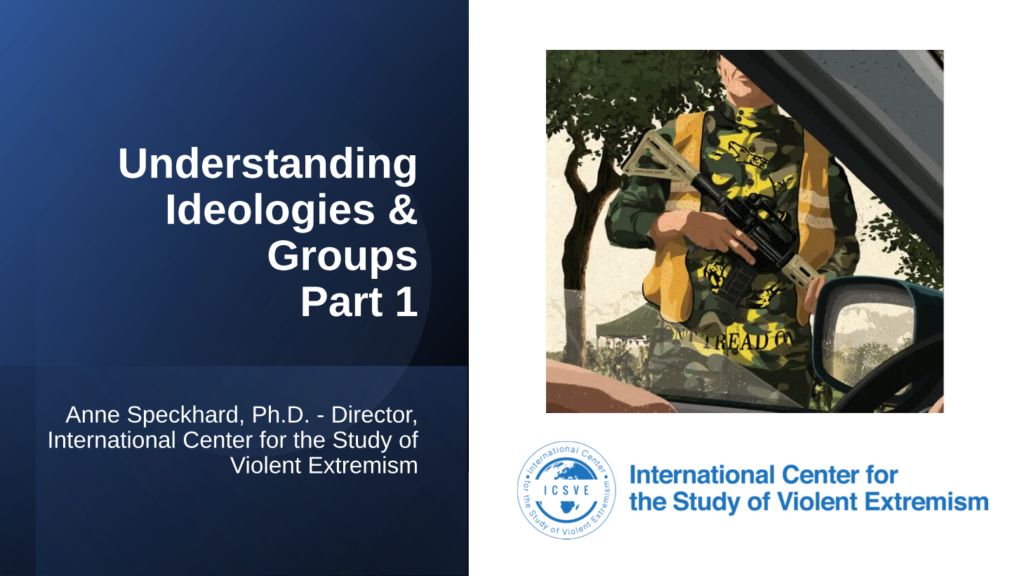
ICSVE 2 Understanding Ideologies and Groups
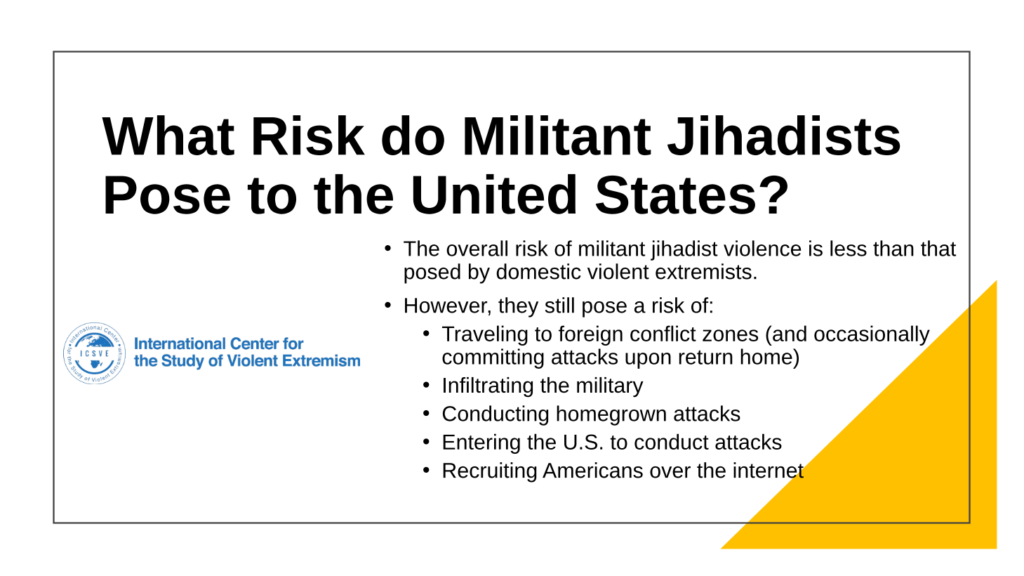
ICSVE 3 How Extremists Enter Communities
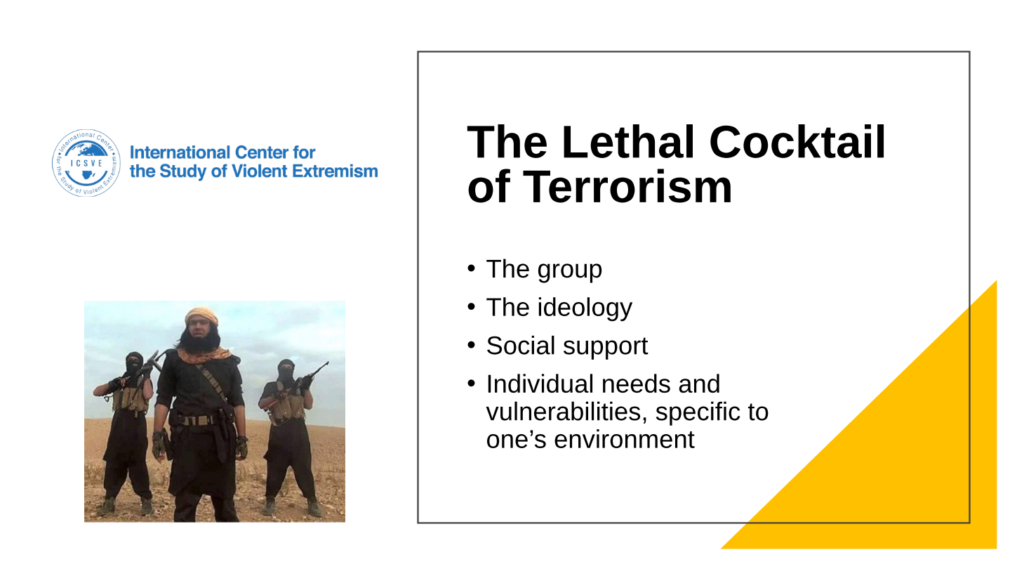
ICSVE 4 What to do about Extremism
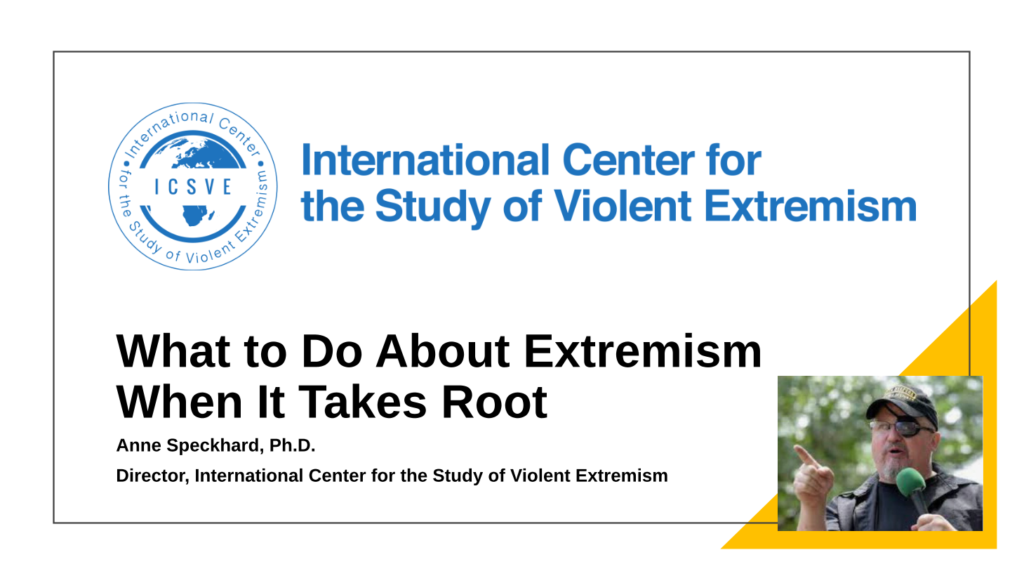
ICSVE 5 Creating a Whole of Society Response
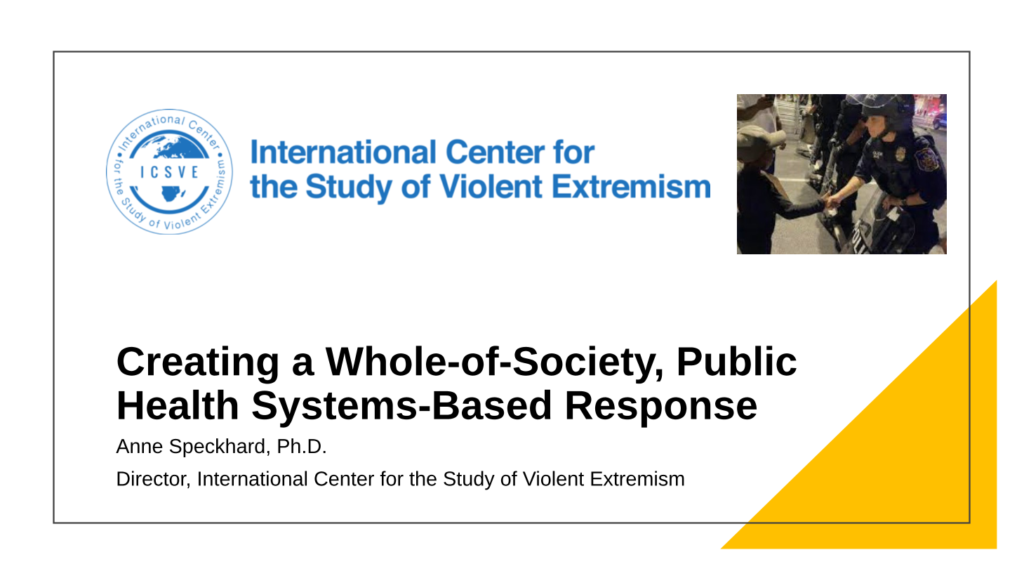
ICSVE 6 Extremist Recruitment and Infiltration in LE
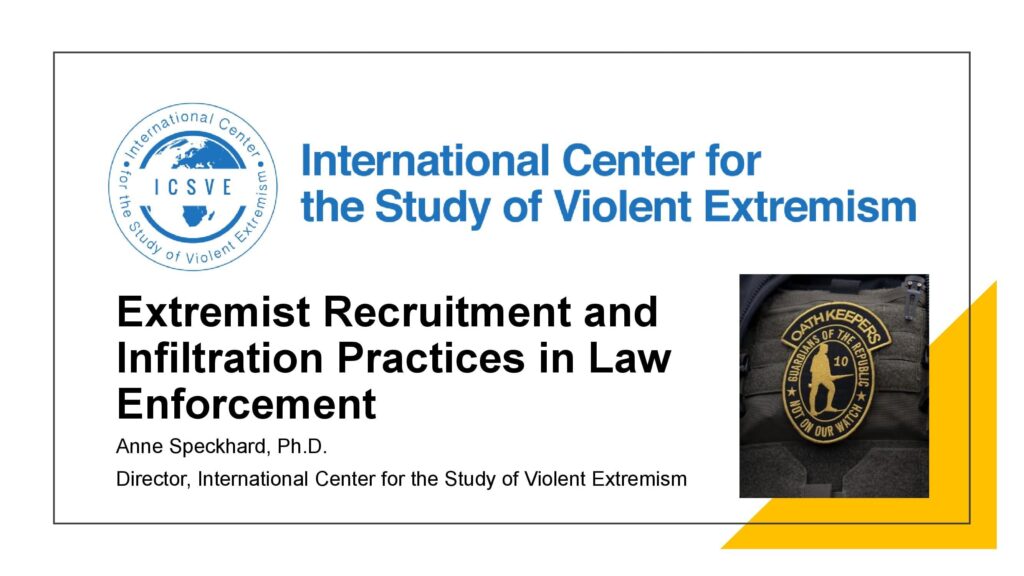




This Post Has 0 Comments